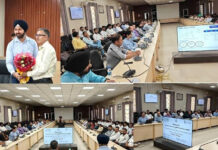NEW DELHI, June 27
Six months after the ‘Pran Pratishtha’ (consecration ceremony) at Ayodhya’s Ram Mandir, the Temple Trust as well as the Ayodhya administration are facing their first challenge — dripping water at the temple and potholes on the road leading up to it.
The city has been witnessing its first heavy rainfall of the monsoon season since Tuesday. The showers have led to water dripping in the ‘gudh mandap’ or hall just outside the temple’s sanctum sanctorum, and caused waterlogging and potholes on Ram Path and other areas. Waterlogging was also reported outside the newly renovated Ayodhya railway station. Authorities are now using heavy machinery to fill the potholes and drain the water.
When The Indian Express visited the temple early morning, there was rainwater dripping from conduit pipes, two under-construction staircases near the sanctum sanctorum and the temporary roof over the ‘gudh mandap’. There were also puddles of water on the way to the mandap, making the marble floor muddy and slippery.The ‘gudh mandap’ is the last point up to which devotees are allowed. The temple’s chief priest, Satyendra Das, claimed there was no drainage system within the temple and there were leaks in the sanctum sanctorum. However, according to temple authorities, the dripping water is due to ongoing work on the temple’s upper levels, where a hall and dome are coming up.
Girish Sahasrabhojanee, the design and construction manager, said: “Recently there has been hue and cry about the leakage everywhere, but the simple fact is that you cannot expect 100 per cent result from a structure which is nearly 80 per cent complete. During the construction phase, there are bound to be some small issues, but there is nothing wrong in the basic design methodology.”
Temple Trust officials also dismissed Das’s allegations of the lack of drainage, with one explaining that it was a deliberate choice to ensure that “holy water doesn’t mix with sewage”.
“These problems will be resolved once the Ram Darbar on the first floor and the dome are completed. We have set the deadline for the year-end,” this Trust official said.
Champat Rai, general secretary of the Trust, denied allegations of a leak. “Since the work on electrical wiring, waterproofing and flooring is in progress on the first floor, water entered from junction boxes…
It looked like water was leaking from the top, but it was actually coming from conduit pipes,” he said, adding that “excellent arrangements” had been made at the temple to drain rainwater “so there will be no waterlogging anywhere”. Near the ‘gudh mandap’ on Wednesday, security personnel stood next to a red bucket, kept to collect rainwater.
According to Sahasrabhojanee, the ‘gudh mandap’ is meant to be over 50 feet high with a dome on top. “The single storey at present is just 20 feet. Work is going on at the upper level and thus it’s open. But we’ve tried to cover and secure it temporarily for safety purposes,” he said.
Two staircases — one to the north of the sanctum sanctorum and the other on the south — are meant to take visitors to the top two floors. “Because it’s a work in progress, the staircase is open on the top (with a temporary roof). Once it’s complete, there will not be any problem at this place,” he said.
Visitors to the temple also had to deal with a waterlogged Ram Janmabhoomi Path — the half-a-kilometre stretch of road that leads to the temple. While the water cleared up in hours, it left behind sludge and mud that devotees had to trudge through barefoot.
The 13-km long road that links the city’s Sadatganj to Naya Ghat also caved in at three places. The road was laid in the run-up to the consecration ceremony.
Authorities said the road was being repaired on priority. “These projects come with defect liability period for this reason,” Ayodhya District Magistrate Nitish Kumar said, adding that “repair is ongoing”.
Ayodhya Mayor Girish Pati Tripathi told The Indian Express: “We have done spot verification and formed different teams; 28 places have been identified as prone to water-logging, officials have been deployed to resolve these issues. Some places were prone to water-logging in the past too as they are in low-lying areas. This is the first rainfall after the new construction, we are resolving all issues immediately.”
At the new Ayodhya Dham railway station, redeveloped at a cost of over `240 crore and inaugurated a month before the consecration ceremony, there was water on the ground floor and first floor. “It’s difficult to drain it all out,” a worker said.



























